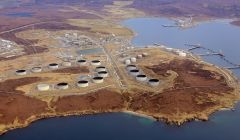Letters / How to make Shetland a UK energy hub
Reports of only two oil tankers loaded at Sullom Voe Terminal within the last four week shows how wastefully under-used the asset is.
Shetland Gas Plant (SGP) supplies the UK with gas via the SIRGE pipeline from the Laggan/Tormore complex with more expected from the Victory, Cambo, Rosebank and other fields, but there are further opportunities to investigate to Shetland’s benefit and finances and the UKs energy security.
Europe/UK needs gas to replace supplies from Russia and liquified natural gas is a practical solution. However the UK import and regasification terminals (Milford Haven, Thames, perhaps Teesside) are unlikely to satisfy the demand and accommodate the interconnector pipeline gas exchange with the continent.
Terminal operator EnQuest could be asked to consider upgrading a SVT jetty to accept -164c LNG (liquified natural gas) cargoes for regasification into the SIRGE pipeline, allowing USA/other imports to reach UK/European markets, bypassing but augmenting the supply from those other ports.
Cryogenic modifications and replacement of Chicksan arms and pipelines would be necessary with perhaps cryogenic buffer storage tanks.
Any cryogenic work and pipelines would facilitate the development of hydrogen activity expected using electricity from wind farms on/off shore.
Due to the longer lead time for Shetland’s main offshore wind power to become available, prior installation and use of lng infrastructure would support the later introduction of electricity from offshore wind and the production of hydrogen ammonia and other derivatives.
In addition to Totalenergies’ interest in the gas fields NW of Shetland and the SVT/SGP, it is partnered by Ineos in these ventures. Ineos operates several Ethane carriers (bp -89c) on transatlantic trade and reports interest to supply the UK with LNG. Could this be done in cooperation with Total who will continue to export LNG from their Cameron USG field.
It would also provide an opportunity to import LNG by vessels from Equinor’s (Statoil) terminal in Hammerfest (north Norway) who also have interests with Shell (Victory) and offshore wind farm proposals off Shetland.
These developments could be accompanied by importing liquid CO2 from Norway, not in the first case for field injection but for further product development and added value at Sullom. The Norsk Hydro (Equinor) Heroya plant may be a source and it is reported that two CO2 carriers (-80/-50c cryogenic range) are being built for Norwegian interests.
All the above would lend itself to make Shetland a UK energy hub, providing jobs and security for a century or more.
The continual negative statements from the SNP and Greens opposing any oil/gas developments whatsoever are concerning, and are in fact not in the best interests of Sullom, Shetland or the UK.
Under those circumstances it would be more beneficial for Shetland ‘to take back control’ and pursue opportunities as a Crown Dependency.
That would permit Shetland’s governance and finances greater room to manoeuvre, providing finance for the construction of tunnels and infrastructure which to date the government have not seen fit to provide and unlikely to do so, notwithstanding the £ billions accrued to national coffers from the oil and gas passing through Sullom.
Cecil Robertson
Inverness


















































































